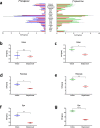SNAPshots of the MCHR1: a Comparison Between the PET-Tracers [18F]FE@SNAP and [11C]SNAP-7941
- PMID: 29948643
- PMCID: PMC6449294
- DOI: 10.1007/s11307-018-1212-0
SNAPshots of the MCHR1: a Comparison Between the PET-Tracers [18F]FE@SNAP and [11C]SNAP-7941
Abstract
Purpose: The melanin-concentrating hormone receptor 1 (MCHR1) has become an important pharmacological target, since it may be involved in various diseases, such as diabetes, insulin resistance, and obesity. Hence, a suitable positron emission tomography radiotracer for the in vivo assessment of the MCHR1 pharmacology is imperative. The current paper contrasts the extensive in vitro, in vivo, and ex vivo assessments of the radiotracers [18F]FE@SNAP and [11C]SNAP-7941 and provides comprehensive information about their biological and physicochemical properties. Furthermore, it examines their suitability for first-in-man imaging studies.
Procedures: Kinetic real-time cell-binding studies with [18F]FE@SNAP and [11C]SNAP-7941 were conducted on adherent Chines hamster ovary (CHO-K1) cells stably expressing the human MCHR1 and MCHR2. Small animal imaging studies on mice and rats were performed under displacement and baseline conditions, as well as after pretreatment with the P-glycoprotein/breast cancer resistant protein inhibitor tariquidar. After the imaging studies, detailed analyses of the ex vivo biodistribution were performed. Ex vivo metabolism was determined in rat blood and brain and analyzed at various time points using a quantitative radio-HPLC assay.
Results: [11C]SNAP-7941 demonstrates high uptake on CHO-K1-hMCHR1 cells, whereas no uptake was detected for the CHO-K1-hMCHR2 cells. In contrast, [18F]FE@SNAP evinced binding to CHO-K1-hMCHR1 and CHO-K1-hMCHR2 cells. Imaging studies with [18F]FE@SNAP and [11C]SNAP-7941 showed an increased brain uptake after tariquidar pretreatment in mice, as well as in rats, and exhibited a significant difference between the time-activity curves of the baseline and blocking groups. Biodistribution of both tracers demonstrated a decreased uptake after displacement. [11C]SNAP-7941 revealed a high metabolic stability in rats, whereas [18F]FE@SNAP was rapidly metabolized.
Conclusions: Both radiotracers demonstrate appropriate imaging properties for the MCHR1. However, the pronounced metabolic stability as well as superior selectivity and affinity of [11C]SNAP-7941 underlines the decisive superiority over [18F]FE@SNAP.
Keywords: Ex vivo; In vitro; In vivo; MCHR1; PET; Small animal imaging; [11C]SNAP-7941; [18F]FE@SNAP.
Conflict of interest statement
The authors declare that there is no conflict of interest.
Figures






Similar articles
-
In vivo evaluation of radiotracers targeting the melanin-concentrating hormone receptor 1: [11C]SNAP-7941 and [18F]FE@SNAP reveal specific uptake in the ventricular system.Sci Rep. 2017 Aug 14;7(1):8054. doi: 10.1038/s41598-017-08684-6. Sci Rep. 2017. PMID: 28808288 Free PMC article.
-
Comparative autoradiographic in vitro investigation of melanin concentrating hormone receptor 1 ligands in the central nervous system.Eur J Pharmacol. 2014 Jul 15;735:177-83. doi: 10.1016/j.ejphar.2014.04.020. Epub 2014 Apr 26. Eur J Pharmacol. 2014. PMID: 24780646
-
[¹⁸F]FE@SNAP-A new PET tracer for the melanin concentrating hormone receptor 1 (MCHR1): microfluidic and vessel-based approaches.Bioorg Med Chem. 2012 Oct 1;20(19):5936-40. doi: 10.1016/j.bmc.2012.07.051. Epub 2012 Aug 7. Bioorg Med Chem. 2012. PMID: 22921745 Free PMC article.
-
Fluorine-18-Labeled PET Radiotracers for Imaging Tryptophan Uptake and Metabolism: a Systematic Review.Mol Imaging Biol. 2020 Aug;22(4):805-819. doi: 10.1007/s11307-019-01430-6. Mol Imaging Biol. 2020. PMID: 31512038 Free PMC article.
-
An Exposition of 11C and 18F Radiotracers Synthesis for PET Imaging.Curr Radiopharm. 2021;14(2):92-100. doi: 10.2174/1874471013666201201095631. Curr Radiopharm. 2021. PMID: 33261547 Review.
Cited by
-
Artificial Intelligence Algorithm-Based Positron Emission Tomography (PET) and Magnetic Resonance Imaging (MRI) in the Treatment of Glioma Biopsy.Contrast Media Mol Imaging. 2022 Mar 23;2022:5411801. doi: 10.1155/2022/5411801. eCollection 2022. Contrast Media Mol Imaging. 2022. PMID: 35386726 Free PMC article.
-
In vitro Radiopharmaceutical Evidence for MCHR1 Binding Sites in Murine Brown Adipocytes.Front Endocrinol (Lausanne). 2019 Jun 11;10:324. doi: 10.3389/fendo.2019.00324. eCollection 2019. Front Endocrinol (Lausanne). 2019. PMID: 31244769 Free PMC article.
-
Discovery of melanin-concentrating hormone receptor 1 in brown adipose tissue.Ann N Y Acad Sci. 2021 Jun;1494(1):70-86. doi: 10.1111/nyas.14563. Epub 2021 Jan 27. Ann N Y Acad Sci. 2021. PMID: 33502798 Free PMC article.
References
Publication types
MeSH terms
Substances
Grants and funding
LinkOut - more resources
Full Text Sources
Other Literature Sources

